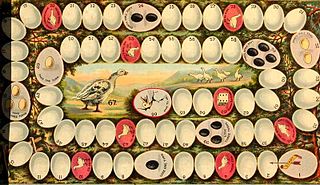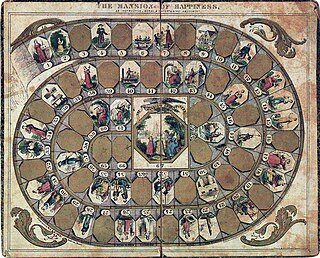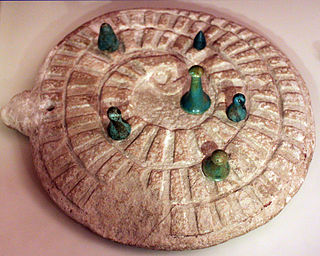 W
WBoard games are tabletop games that typically use pieces moved or placed on a pre-marked board and often include elements of table, card, role-playing, and miniatures games as well.
 W
WThe 3M bookshelf game series is a set of strategy and economic games published in the 1960s and early 1970s by 3M Corporation. The games were packaged in leatherette-look large hardback book size boxes in contrast to the prevalent wide, flat game boxes. The series grew to encompass over three dozen games. Most were multi-player board games or card games; a few were trivia games or two-handed board games. Acquire and TwixT were among the best-selling titles. The series later became part of the Avalon Hill Bookcase games. Very few of these games are still being published.
 W
WAlquerque is a strategy board game that is thought to have originated in the Middle East. It is considered to be the parent of draughts and Fanorona.
 W
WThe Game of the Goose or Goose game is a board game where two or more players move pieces around a track by rolling one or two dice. The aim of the game is to reach square number sixty-three before any of the other players, while avoiding obstacles such as the Inn, the Bridge, and Death.
 W
WGlückshaus (House of Fortune) is a medieval gambling dice game for multiple players. It is played with two dice on a numbered board.
 W
WHounds and jackals is the modern name given to an ancient Egyptian game that is known from several examples of gaming boards and gaming pieces found in excavations. The modern game was discovered by Howard Carter, who found one complete gaming set in a Theban tomb of ancient Egyptian pharaoh Amenemhat IV that dates to the 12th Dynasty. The latter game set is one of the best preserved examples and is today in the Metropolitan Museum of Art in New York. He called it "Hounds contra Jackals". Another, less often used modern name is "fifty-eight holes".
 W
WThe Landlord's Game is a board game patented in 1904 by Elizabeth Magie as U.S. Patent 748,626. It is a realty and taxation game intended to educate users about Georgism. It is the inspiration for the board game Monopoly.
 W
WLiubo is an ancient Chinese board game played by two players. For the rules, it is believed that each player had six game pieces that were moved around the points of a square game board that had a distinctive, symmetrical pattern. Moves were determined by the throw of six sticks, which performed the same function as dice in other race games.
 W
WLudus latrunculorum, latrunculi, or simply latrones was a two-player strategy board game played throughout the Roman Empire. It is said to resemble chess or draughts, but is generally accepted to be a game of military tactics. Because of the scarcity of sources, reconstruction of the game's rules and basic structure is difficult, and therefore there are multiple interpretations of the available evidence.
 W
WThe Mansion of Happiness: An Instructive Moral and Entertaining Amusement is a children's board game inspired by Christian morality. Players race about a 66-space spiral track depicting virtues and vices with their goal being the Mansion of Happiness at track's end. Instructions upon virtue spaces advance players toward the goal while those upon vice spaces force them to retreat.
 W
WMehen is a board game which was played in ancient Egypt. The game was named in reference to Mehen, a snake deity in ancient Egyptian religion.
 W
WThe board game Monopoly has its origin in the early 20th century. The earliest known version of Monopoly, known as The Landlord's Game, was designed by an American, Elizabeth Magie, and first patented in 1904 but existed as early as 1902. Magie, a follower of Henry George, originally intended The Landlord's Game to illustrate the economic consequences of Ricardo's Law of Economic rent and the Georgist concepts of economic privilege and land value taxation. A series of board games was developed from 1906 through the 1930s that involved the buying and selling of land and the development of that land. By 1933, a board game had been created much like the modern version of Monopoly sold by Parker Brothers and its related companies through the rest of the 20th century, and into the 21st. Several people, mostly in the midwestern United States and near the East Coast of the United States, contributed to the game's design and evolution.
 W
WPatolli or patole is one of the oldest known games in America. It was a game of strategy and luck played by commoners and nobles alike. It was reported by the conquistadors that Moctezuma Xocoyotzin often enjoyed watching his nobles play the game at court.
 W
WRithmomachy is a highly complex, early European mathematical board game. The earliest known description of it dates from the eleventh century. A literal translation of the name is "The Battle of the Numbers". The game is much like chess, except most methods of capture depend on the numbers inscribed on each piece.
 W
WThe Royal Game of Ur, also known as the Game of Twenty Squares, is a two-player strategy race board game that was first played in ancient Mesopotamia during the early third millennium BC. The game was popular across the Middle East among people of all social strata and boards for playing it have been found at locations as far away from Mesopotamia as Crete and Sri Lanka. At the height of its popularity, the game acquired spiritual significance, and events in the game were believed to reflect a player's future and convey messages from deities or other supernatural beings. The Game of Ur remained popular until late antiquity, when it stopped being played, possibly evolving into, or being displaced by, an early form of backgammon. It was eventually forgotten everywhere except among the Jewish population of the Indian city of Kochi, who continued playing a version of it until the 1950s when they began emigrating to Israel.
 W
WSenet is a board game from ancient Egypt. The earliest representation of senet is dated to c. 2620 BCE from the Mastaba of Hesy-Re, while similar boards and hieroglyphic signs are found even earlier. The game fell out of use following the Roman period, and its original rules are the subject of conjecture.
 W
WTafl games are a family of ancient Nordic and Celtic strategy board games played on a checkered or latticed gameboard with two armies of uneven numbers. Most probably they are based upon the Roman game Ludus latrunculorum. Names of different variants of Tafl include Hnefatafl, Tablut, Tawlbwrdd, Brandubh, Ard Rí, and Alea Evangelii. Games in the tafl family were played in Norway, Sweden, Denmark, Iceland, Britain, Ireland, and Lapland. Tafl gaming was eventually supplanted by chess in the 12th Century, but the tafl variant of the Sami people, tablut, was in play until at least the 1700s. The rules for tablut were written down by the Swedish naturalist Linnaeus in 1732, and these were translated from Latin to English in 1811. All modern tafl games are based on the 1811 translation, which had many errors. New rules were added to amend the issues resulting from these errors, leading to the creation of a modern family of tafl games. In addition, tablut is now also played in accordance with its original rules, which have been retranslated.